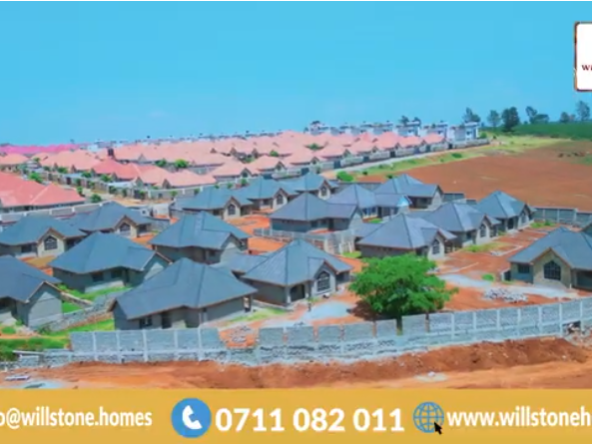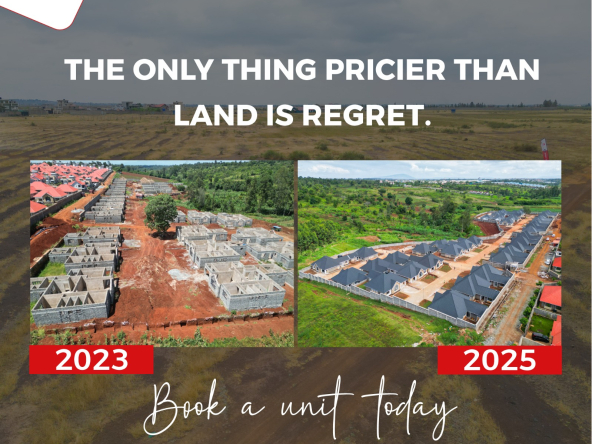If you’re building (not buying) a home in Kenya, a construction mortgage is the tool that turns your drawings and Bill of Quantities into a livable house—without tying up all your cash up front. Kenya’s mortgage market remains small but important: by December 2024 there were 30,016 mortgage accounts nationwide with an outstanding value of KSh 279.3 billion, an average interest rate of 14.9%, and an average mortgage maturity of 11.1 years. The construction segment sits inside this market and works a bit differently from purchase mortgages—funds are released in stages and you pay interest only on what you’ve actually drawn.
What is a Construction Mortgage?
A Kenyan construction mortgage (sometimes called a “home construction loan”) finances the cost of building a dwelling on land you already own (or are acquiring concurrently). Unlike a purchase mortgage that pays a seller in one lump sum, a construction mortgage disburses in tranches tied to build stages (e.g., foundation, walling, roofing, finishes). During construction, you typically service interest only on the amount already disbursed; once the house is complete, the facility converts into a standard mortgage and you begin normal amortizing repayments. Kenyan lenders describe these mechanics consistently.
Read Also: A Rock in the Construction Industry. A Name You Can Trust – WILLSTONE HOMES
How a Construction Mortgage Works
1) Tranche disbursements and stage valuations
Banks release money only after a bank-appointed valuer confirms the previous stage is complete. Some lenders allow many small tranches (Absa notes up to 12 disbursements, with interest charged only on the amount disbursed), which can help cash-flow.
2) Equity contribution
Expect to bring equity—often via the land you already own and/or cash. For example, NCBA states a minimum 30% customer contribution of the gross development cost; other lenders may fund up to 100% of construction cost if the land is your equity and all approvals are in place. Terms vary by lender and risk profile.
3) During-construction repayments (interest-only)
Illustration using the market’s average mortgage rate (~14.9%):
- Disbursed KSh 2.5m → monthly interest ≈ KSh 31,000.
- After the second tranche total disbursed KSh 5m → ≈ KSh 62,000.
- After full KSh 10m disbursed → ≈ KSh 124,000.
Your actual pricing is risk-based and may be higher or lower, but the interest-only feature is standard during construction.
4) Conversion to a long-term mortgage
After completion and occupation certificate, lenders “term out” the balance into a regular mortgage—often up to 20 years—so your monthly instalment drops from interest-only to a blended principal+interest repayment.
Costs You Should Plan For (beyond bricks and mortar)
- County plan approval & inspections (Nairobi example): The Nairobi City County Finance Act, 2023 pegs plan evaluation at 0.5% of construction cost (plus filing/inspection and other post-approval fees). Other counties set their own schedules.
- NCA Project Registration & Levy: For projects meeting NCA thresholds, pay the NCA levy of 0.5% of the contract sum and register the project/contractor.
- Stamp duty on land transfer: 4% urban / 2% rural (location-based), per national rules.
- Stamp duty on the mortgage charge: Commonly 0.1% of the charge amount (banks disclose this in their cost breakdowns).
- Bank/third-party charges (illustrative from lender disclosures):
- Negotiation/arrangement fee 1–2% of the loan.
- Legal fees ~1.2% (per lender’s schedule with their panel advocates).
- Valuation fees ~0.25% (initial and stage valuations).
- Fire/property insurance (typical lender-quoted loadings).
- Mortgage protection (credit life).
Tip: These transactional/ancillary costs are often not funded inside the construction facility. Budget them in cash to avoid delays.
Read Also: Harambee Stars Inspire Kenyans—And Willstone Homes Shows How Dreams Are Built
Lender Snapshots
| Lender | Funding & Tenor (headline) | Disbursement & During-Build | Notable Requirements / Notes |
|---|---|---|---|
| Absa Kenya | Construction loan; variable or KMRC fixed options | Up to 12 disbursements; interest only on amount disbursed | Panel valuer, approved plans, BQ by QS; published breakdown of typical fees (negotiation 1–2%, legal ~1.2%, valuation ~0.25%, stamp duty on charge 0.1%). |
| Stanbic Bank | Finance up to 100% of construction cost; up to 12 months build then convert to up to 20-year mortgage | Stage-based releases; interest-only during build | Payslips/statements; QS, architect & contractor practicing certificates; NEMA certification where applicable. |
| NCBA | Construction finance; customer contributes ≥30% of gross development cost | Stage valuations; converts to mortgage on completion | Title, approved drawings, BQ signed by QS, contractor profile, permits; detailed document checklist online. |
| Standard Chartered (KMRC-backed) | Fixed ~9.5% up to 25 years for eligible affordable housing loans (purchase and construction) | Converts to long tenure; eligibility & property value caps apply | KMRC window via bank; docs per standard mortgage plus approvals. |
| Co-operative Bank (Good Homes / KMRC) | Good Homes range includes construction; KMRC product advertises ~9.9% fixed and up to 90% LTV for building | Grace period options; conversion to term mortgage | Variety of mortgage options; specific terms vary by product line. co-opbank.co.ke+1 |
Current market conditions to note
- Policy rate backdrop: CBK’s Central Bank Rate (CBR) is 10.5% (as at 10 June 2024 meeting), and banks price risk-based spreads above this. That’s why typical mortgage quotes cluster in the low-to-mid teens even before fees.
- Mortgage book metrics: As of Dec 2024, Kenya’s mortgage book had 30,016 loans outstanding (KSh 279.3bn), average interest 14.9%, average term 11.1 years, and a mortgage NPL ratio ~16.5%—a reminder to stress-test affordability. Rough average balance ≈ KSh 9.3m (derived by dividing outstanding by accounts).
- Longer tenors via KMRC: Some banks now offer fixed-rate, long-tenor loans (often 20–25 years) on KMRC-eligible deals—including construction—which can materially lower monthly instalments if you qualify.
How to Apply for a Construction Mortgage in Kenya (step-by-step)
- Confirm land & ownership
- You must have a clean title deed (freehold or leasehold) with no encumbrances (or acceptable ones to be settled/novated). Conduct a search at the Lands Registry and ensure rates/rent are up to date.
- Get professional designs & approvals
- Engage a registered architect and quantity surveyor to produce architectural drawings and a Bill of Quantities (BQ).
- Secure county approvals (e.g., Nairobi plan evaluation 0.5% of construction cost, plus statutory fees), and where applicable, NCA project registration and NCA levy 0.5%.
- Pick your lender & product
- Compare: interest rate type (variable vs KMRC fixed), tenor (build period + mortgage period), max LTV/equity, fees and disbursement flexibility. Lender pages outline these features.
- Prepare the application file (expect most of the following)
- ID & KRA PIN, recent payslips (e.g., 3–6 months) and bank statements (often 6–12 months).
- Title, arch drawings, approved plans/permits, BQ (QS-signed), contractor/consultants’ practicing certificates, NEMA certificate where applicable. Lenders publish checklists.
- Valuation & offer letter
- The bank appoints a valuer to confirm land value and the staged build values. If the valuation supports your budget and affordability passes, the bank issues a Letter of Offer with pricing, tenor, security and drawdown conditions. (Some lenders indicate fast turnarounds once documents are complete.)
- Security perfection & insurance
- You’ll register a charge over the property (stamp duty on charge typically 0.1%), execute legal documents with panel advocates, and take fire/property insurance and mortgage protection. Expect arrangement/legal/valuation fees per lender schedules.
- Drawdowns & inspections
- Funds are released stage-by-stage to your contractor (or to you per bank rules) after each site inspection/valuation. Keep invoices, photos, and certificates tidy to avoid delays.
- Practical completion & conversion
- After completion certificate/occupation permit, the facility converts to a standard mortgage for the agreed tenor (often up to 20 years; 25 years possible under some KMRC windows).
Common pitfalls (and how to avoid them)
- Under-estimating soft costs: County fees, NCA levy (0.5%), valuations, legal, and stamp duties add up. Keep a cash buffer beyond your BQ.
- Changing scope mid-build: Variations trigger re-valuations and can stall tranches. Lock the design early.
- Unregistered professionals/contractor: Banks may reject disbursement without proper practicing certificates; some lenders explicitly require them.
- Ignoring fixed-rate options: If you qualify for KMRC-backed financing, the fixed rate and longer tenor can materially improve affordability.
Quick data table: Kenya’s Mortgage Market
| Indicator (Dec 2024) | Value |
|---|---|
| Number of mortgage accounts | 30,016 |
| Outstanding mortgage value | KSh 279.3 billion |
| Average mortgage interest rate | 14.9% |
| Average mortgage maturity | 11.1 years |
| Mortgage NPL ratio | ~16.5% |
Source: Central Bank of Kenya, Bank Supervision Annual Report 2024 (Mortgage Survey Highlights).
Read Also: How to Save for a 4-Bedroom, KES 10 Million House in Kenya
Making “Construction Mortgage Kenya” Work for You
A construction mortgage in Kenya lets you build in stages, pay interest only on what you’ve used, and convert to a long-term mortgage at completion. To get the best outcome: line up approvals early, choose a lender whose disbursement flexibility, tenor, and rate type (variable vs KMRC fixed) fit your cash-flow, and budget for the soft costs—county approvals (e.g., Nairobi 0.5% of construction cost), NCA levy (0.5%), legal, valuation, and stamp duties. With careful planning, construction mortgage Kenya financing can turn your plans into a finished home—without derailing your monthly budget.
Sources
- Central Bank of Kenya – Bank Supervision Annual Report 2024 (Mortgage Survey Highlights). Central Bank of Kenya
- CBK Monetary Policy Committee – CBR decisions (10.5% as of 10 June 2024).
- Absa Bank Kenya – Mortgage & Construction Loan features and cost breakdown. Absa
- Stanbic Bank Kenya – Construction finance features & documentation. Stanbic Bank
- NCBA Bank Kenya – Construction finance requirements & customer contribution. ke.ncbagroup.com
- Standard Chartered Kenya – KMRC-backed fixed-rate mortgages (incl. construction). Wise
- Co-operative Bank of Kenya – Good Homes mortgage range; KMRC parameters. co-opbank.co.ke+1
- Nairobi City County – Finance Act 2023 (0.5% plan evaluation). Nairobi City County Assembly
- NCA – Levy Calculator (0.5% of contract sum). ke.ncbagroup.com
- CMS Africa – Stamp duty 4% urban / 2% rural.




